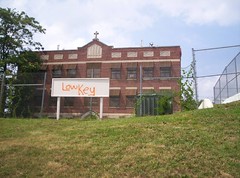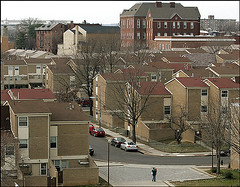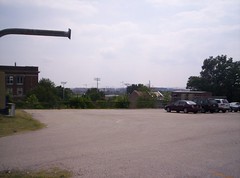9 construction cranes and the Washington Monument (Eckington)
(I wish I had my old camera--stolen--with the 10x zoom, for this shot.)
This development site involving a Catholic organization, which proposes a 100% affordable housing community, is across from McKinley High School in the Eckington neighborhood.
Some residents want a greater mix of incomes represented in the development, given recent lessons from housing history generally and more locally, especially with regard to the nearby Sursum Corda and the overconcentration of low income residents (Sursum Corda is crime-ridden).
The neighborhood also has a concentration of social service programs, including methadone treatment clinics in the vicinity of North Capitol and Florida and New York Avenues.
 I'm told that negotiations with the DC Preservation League over an historic designation application are leading to some real positive changes in how the project is being designed.
I'm told that negotiations with the DC Preservation League over an historic designation application are leading to some real positive changes in how the project is being designed.Oh, speaking of design, the original designs were pretty bad. Good design generally contributes to creating better neighborhoods. Average to bad design appears to contribute to blight.
For more on this subject, see Tensions Boil Over Affordable Housing, subtitled "NE Neighbors Protest Plan to Turn Former Convent Into Large Apartment Building," from the Washington Post, back April.
Speaking of Sursum Corda, see this article from the Post a couple weeks ago, "Williams Signs Bill For Housing Plan."
 The Sursum Corda complex in Northwest, shown in February, is to become a mixed-income community. (By Nikki Kahn -- The Washington Post).
The Sursum Corda complex in Northwest, shown in February, is to become a mixed-income community. (By Nikki Kahn -- The Washington Post).I have been meaning to write about the Eckington project since April, but didn't get around to it. Below is one side of correspondence I had with someone who works in the housing arena, who because of his position in government, needs to stay anonymous.
While I do not live in that neighborhood, I am involved in some of the goings-on there, especially as they relate to this. I think there are radicals on both sides of the debate and both sides are blowing things a little out of the water. This is by no means a "Sursum Corda" (which serves a population largely below 30% of AMI).
It will predominately house people at 60% of AMI, which is working class any way you slice it. Judging by other similar tax credit buildings, I have no doubt it will be professionally managed, meaning that tenants who might bring "blight" to the neighborhood, though drug sales or use or other less salubrious deeds, will quickly be evicted (the owners do have a bottom line to tend to).
On a more moral scale, I think the effort to bring affordable housing to DC, especially in an appealing neighborhood east of the river, is invaluable. Unfortunately, it has become so demonized (due in so small part to rather appalling and visible housing policies of the past), that the dreaded "NIMBYism" and other fearmongering is not surprising.
The beauty of homeownership is that homeowners care, even if those concerns and fears run counter to greater ideals at times. They are no doubt rational and intelligent people, so education should be the goal of these developers, not race-baiting or name-calling.
From an urban design standpoint, I do not think that this is necessarily the most aesthetic way to improve the neighborhood. It will no doubt improve the streetscape and increase pedestrian (and automobile) traffic in the area. I wonder how seriously the developers have considered building the as-of-right townhomes, given that they could likely get a similar yield, create some affordable homeownership opportunities, and avoid dividing the neighborhood along such silly lines.
The problem with as-of-right development is that it would include even fewer spaces per bedroom and probably worsen the traffic and parking concerns that such are a large concern of the neighbors.
People on both sides of the debate have begun to elevate it to one with citywide implications. Depending on which side you stand, it's either about the ability of neighbors to determine what happens in their neighborhoods or the ability of the city and developers to build affordable housing in DC. I question whether this will really set the precedent, as I believe much of it was caused by a lack of engagement by the developer.
But because it is perceived as the "line in the sand" I think the battle will neither end soon nor end without great animosity within a neighborhood. It is too bad, considering all sides want what they think will be best for the area. I can only hope that the more rational parties of both sides can come together and work out an acceptable solution.
Index Keywords: housing




0 Comments:
Post a Comment
<< Home